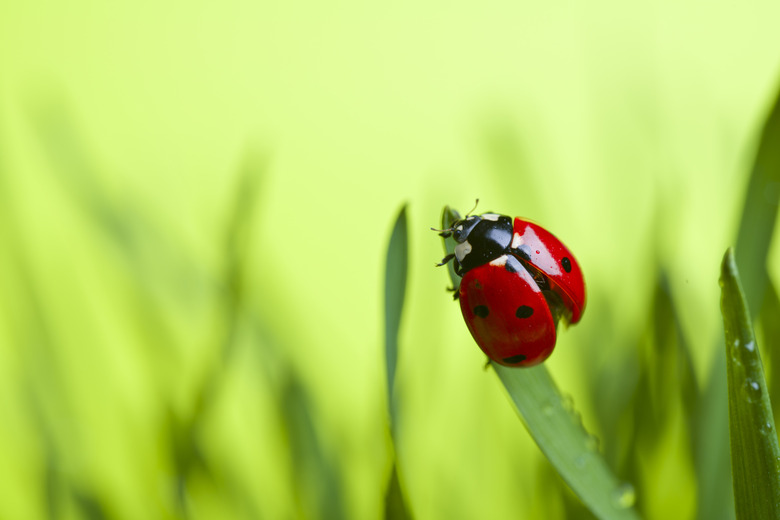The Meanings Of The Colors Of Ladybugs
The conspicuous colors of ladybugs contrast sharply with the green foliage they inhabit, and they're hard to overlook. These little round beetles are mostly predators, eating aphids and other harmful insects. The U.S. contains over 500 species of ladybugs, and there are over 4,500 kinds worldwide. They're used as biological control agents, and some species have been introduced from other countries for this purpose. The bright colors indicate the bad taste ladybugs have, discouraging predators from eating them.
Warning Colors
Warning Colors
Some animals have warning colors to advertise poisonous or distasteful properties, such as brightly colored wasps, caterpillars, butterflies and frogs. Called "aposematic coloration," conspicuous colors and arrangements of color patterns help potential predators identify and avoid these creatures after tasting or experiencing them once.
Ladybugs not only taste bad, but they also exhibit a behavior called "reflex bleeding" when threatened. They exude a yellow fluid from their leg joints that smells, tastes bad, and can cause an allergic reaction in humans. That's enough to repel birds and other predators such as frogs, wasps, dragonflies and spiders.
Color and Climate
Color and Climate
In the Netherlands, Paul Brakefield from the University of Cambridge conducted a 30-year study of two-spotted ladybugs which showed a change in the distribution of beetle color phases. Two color phases exist: nonmelanic (red beetle with black spots) and melanic (black beetle with red spots). In 1980, ladybugs near the coast were 90 percent nonmelanic and 10 percent melanic, while beetles inland were 60 percent nonmelanic and 40 percent melanic. Brakefield suggested that darker beetles in the cooler interior stayed warmer and lighter beetles near the coast kept cooler.
In 2004 only 20 percent of ladybugs in any area were black with red spots, corresponding to consistent climate warming in the area over the period. Brakefield ended the study when the native beetles became scarce, outcompeted by the Japanese harlequin ladybug which escaped from a Belgian greenhouse which was using it as a biological control agent.
Identification
Identification
Ladybugs have the most prominent color on their wing covers, or "elytra". When they fly, they raise these wing covers to free their transparent membranous wings. The area right in front of the wing covers, the thorax, can also have conspicuous patterning. Scientists who study insects are called entomologists. Entomologists have long used the color, number, shape and arrangement of dots to identify different species of ladybugs. Common names reflect this, such as the two-spotted ladybug, the parenthesis ladybug, the seven-spotted ladybug, the nine-spotted ladybug and the checker spot ladybug.
Variability Within a Species
Variability Within a Species
Sometimes there are great differences between individuals of the same species of ladybug regarding elytra color and number, shape and color of spots. The multicolored Asian lady beetle has a wider range of colors and spot numbers than other ladybugs. Introduced into the U.S. from Asia, the beetle began spreading throughout the country from Louisiana in 1988. Their colors range from mustard to red with zero to many black spots.
Many other species show variation, such as the ten-spotted ladybug, which makes species identification difficult. As John Sloggett and Alois Honek remark in their chapter on ladybug genetics in "Ecology and Behaviour of the Ladybird Beetles (Coccinellidae)," despite many studies on ladybug color patterns, scientists "...know very little about the genetic and developmental pathways that underlie colour pattern production."
References
- Lost Ladybug Project: All About Ladybugs
- North Carolina State University: General Entomology: Insect Defenses
- American Association for the Advancement of Science: News: Ladybugs Changed Color in Response to Climate Change
- Lost Ladybug Project: Basic Field Guide: Are You a Nine-spotted Ladybug?
- Nature Spot: 10 Spot Ladybird – Adalia Decempunctata
- Genetic Studies; John J. Sloggett and Alois Honek.
Cite This Article
MLA
Csanyi, Carolyn. "The Meanings Of The Colors Of Ladybugs" sciencing.com, https://www.sciencing.com/meanings-colors-ladybugs-8603989/. 23 May 2019.
APA
Csanyi, Carolyn. (2019, May 23). The Meanings Of The Colors Of Ladybugs. sciencing.com. Retrieved from https://www.sciencing.com/meanings-colors-ladybugs-8603989/
Chicago
Csanyi, Carolyn. The Meanings Of The Colors Of Ladybugs last modified August 30, 2022. https://www.sciencing.com/meanings-colors-ladybugs-8603989/
